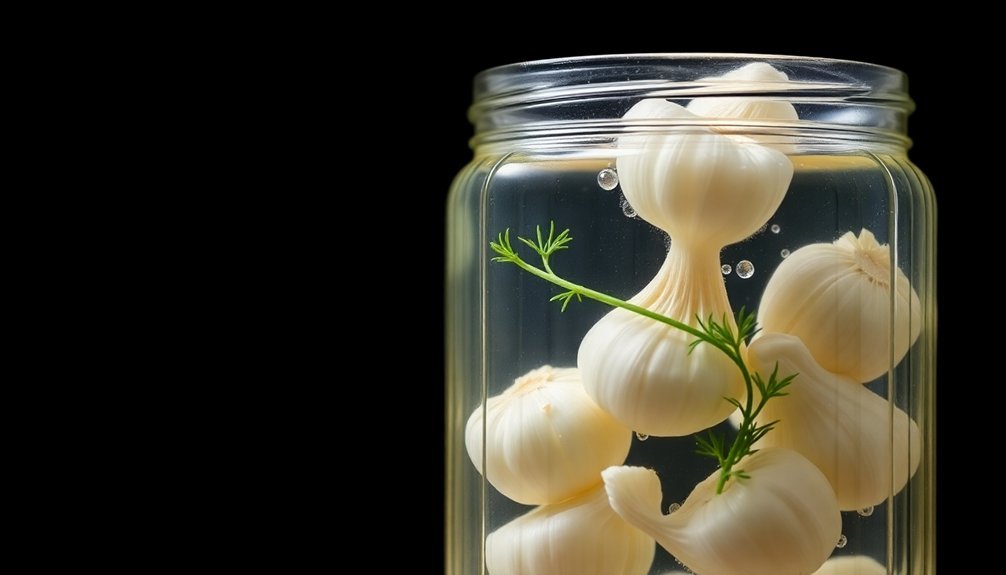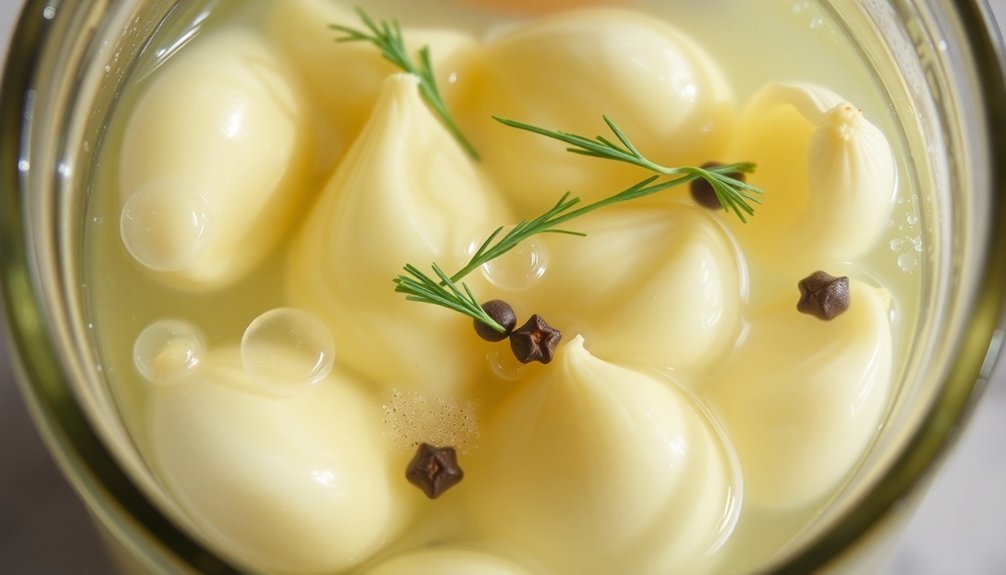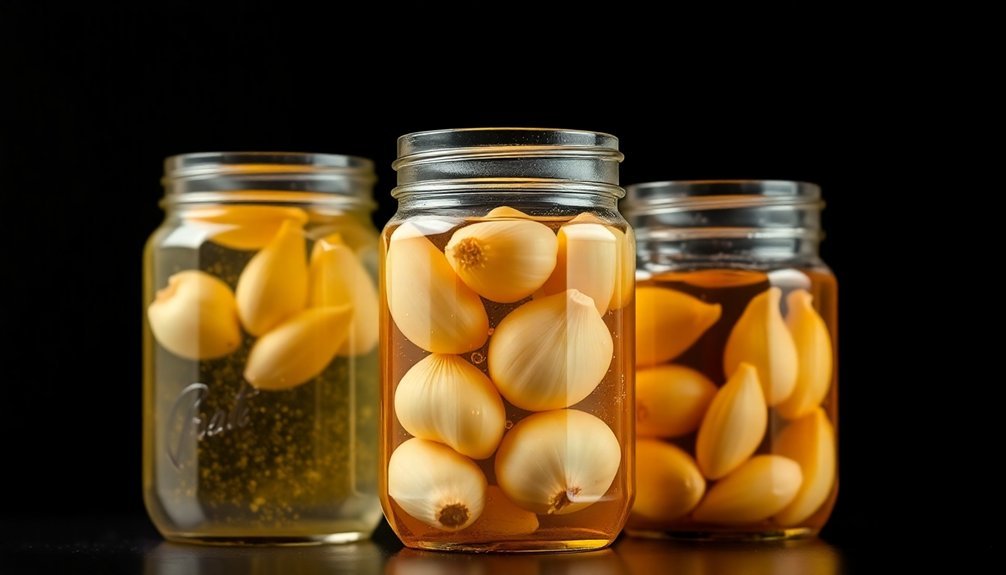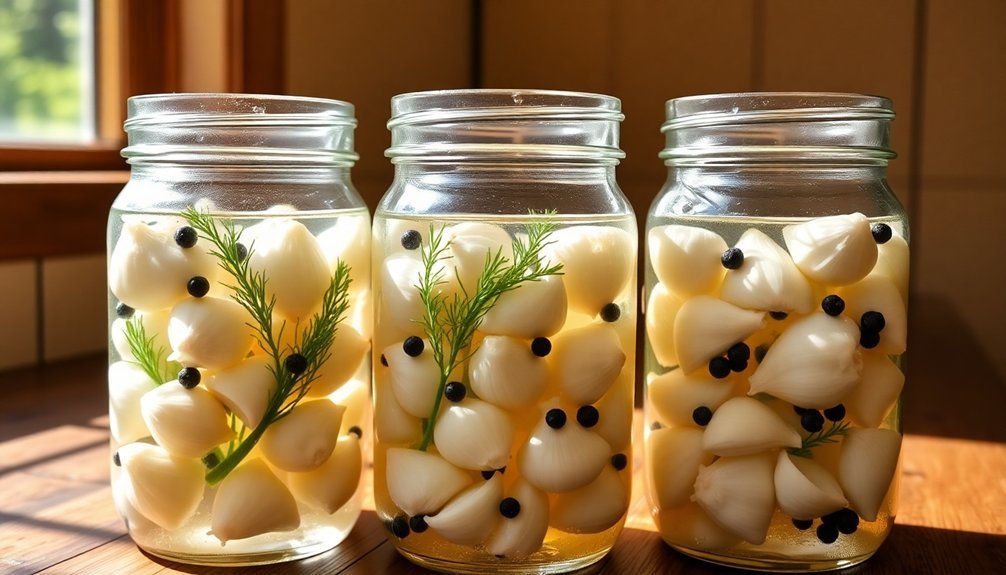Your pickled garlic stays fresh for months due to its highly acidic environment, which naturally prevents harmful bacteria from growing. When you properly pickle garlic in vinegar or citric acid solutions with a pH level below 4.6, you create ideal preservation conditions. The acid penetrates the chopped garlic's surface while proper storage techniques – like using airtight containers and keeping the cloves fully submerged in brine – further extend shelf life. You'll also want to keep your pickled garlic refrigerated at around 40°F in a dark place. Understanding the complete preservation process can help you safely enjoy your pickled garlic even longer.
The Science of Acidity

The science behind pickled garlic's longevity lies in its acidic environment. When you pickle garlic, you're creating conditions that most harmful bacteria simply can't survive in. The key is maintaining a pH level of 4.6 or lower, which effectively prevents the growth of dangerous pathogens like Clostridium botulinum, the bacteria responsible for botulism.
You'll find that acidification can be achieved through various food-grade acids, such as vinegar or citric acid. In the case of pickled garlic, a 3% citric acid solution mixed at a 1:3 ratio with garlic creates an ideal preservative environment.
By chopping the garlic, you're increasing its surface area, which allows the acid to penetrate more effectively and quickly achieve the target pH of 4.2 or lower within 24 hours.
The process isn't just about adding acid – it's about creating a stable environment that's inhospitable to microorganisms. This is why commercial producers carefully monitor and document pH levels throughout the pickling process.
When properly acidified, your pickled garlic can maintain its safety and quality for several months, all while developing its characteristic sour taste.
Safe Storage Best Practices
Proper storage practices play an essential role in maintaining your pickled garlic's safety and quality over time. To maximize shelf life, you'll need to store your pickled garlic in airtight containers, ensuring the garlic remains fully submerged in the brine solution.
When sealing jars, screw the lids on until they're finger-tight and verify the rims are clean for a proper seal. Your preserved garlic can last up to year when properly stored and sealed.
Keep your pickled garlic in a cool, dark place, ideally at refrigeration temperatures around 40°F (4°C). Avoid areas with high humidity or direct sunlight exposure, as these conditions can compromise the preservation process.
If you're planning to freeze your pickled garlic, remember to leave room in the container for expansion.
You'll need to monitor your pickled garlic regularly for quality and safety. Conduct visual inspections to check for any signs of spoilage, such as discoloration, sliminess, mold, or unusual odors.
If you notice any of these warning signs or if the product has passed its use-by date, discard it immediately.
Regular maintenance includes ensuring the garlic stays submerged in the brine to prevent air exposure and bacterial contamination.
Protecting Against Bacterial Growth

Building on safe storage practices, effective bacterial control requires multiple protective measures working together.
You'll need to maintain a consistently acidic environment by using full-strength vinegar in your pickling brine, which creates a pH around 3.0. This acidity effectively prevents harmful bacteria like Clostridium botulinum from growing and stops spores from germinating. The minimum vinegar strength must be at least 5% to ensure proper preservation.
Refrigeration adds another vital layer of protection, as cold temperatures considerably slow bacterial activity. Even with proper acidification, you should always store your pickled garlic in the refrigerator, where it can safely last up to 4 months while preventing mold and yeast growth.
You'll want to avoid creating anaerobic conditions at all costs. Never store garlic in oil, as this oxygen-free environment can promote the growth of dangerous bacteria that produce toxins without changing the food's taste or smell.
Instead, stick to vinegar-based solutions that maintain aerobic conditions.
Use the right materials for safety: opt for distilled water to avoid mineral interference, choose stainless steel or enamel cookware, and use kosher or sea salt instead of iodized salt.
These choices help maintain consistent pickling conditions and prevent unwanted chemical reactions.
Proper Sealing Methods
Securing an airtight seal on your pickled garlic jars requires careful attention to detail and the right technique.
You'll need to fill sterilized pint jars with hot pickling liquid, leaving a half-inch of headspace at the top. Once filled, remove any air bubbles using a plastic knife, skewer, or chopstick to guarantee all garlic cloves are fully submerged in the liquid.
To properly seal your jars, clean the rims thoroughly and center the lids before adjusting the bands to fingertip-tight. Process the jars in boiling water for 10 minutes, making sure they're covered by at least an inch of water. Allow at least three weeks of chilling for the garlic to develop its optimal flavor profile.
After processing, let them cool for 5 minutes, then wait 12 hours before checking the seals.
When you've sealed your jars correctly, you can store them in the refrigerator for up to 4 months. However, if any jars don't seal properly, use them within 3 weeks.
Keep your sealed pickled garlic away from direct sunlight and maintain a consistent refrigerator temperature. Remember to use only stainless steel or enamel cookware and utensils during the process to avoid unwanted chemical reactions.
Monitoring Quality Over Time

Regular monitoring of your pickled garlic's quality guarantees both safety and ideal flavor throughout its storage period. You'll need to routinely check for any signs of spoilage, including discoloration, sliminess, mold growth, or unusual odors. If you notice any of these indicators, it's best to discard the product immediately.
Keep track of your pickled garlic's pH and salinity levels to make certain they remain within safe ranges. The brine's pH should stay below 2.5, while salinity needs to maintain levels above 22 °Bé. You can use pH strips or a digital meter for accurate measurements.
It's also essential to conduct regular visual inspections and occasional taste tests to verify the product's quality.
Store your pickled garlic in the refrigerator to prevent botulism risk and maintain consistent quality. You shouldn't keep it at room temperature, as this can lead to unwanted mold and yeast growth.
If you're looking to extend shelf life even further, you can freeze your pickled garlic for up to three months. Don't forget to label containers with preparation dates and 'best before' dates to help track storage duration.
Frequently Asked Questions
Can Pickled Garlic Cloves Turn Blue or Green During the Pickling Process?
Yes, your pickled garlic cloves can turn blue or green due to a chemical reaction between enzymes, sulfur compounds, and acids. Don't worry though – it's completely safe to eat and won't affect flavor.
Does the Type of Vinegar Used Affect the Final Taste Significantly?
Yes, your choice of vinegar greatly impacts the final taste. You'll get richer flavors with red wine vinegar, sharper notes with white vinegar, and subtle sweetness with apple cider vinegar in your pickled garlic.
Can I Reuse the Pickling Liquid for a New Batch of Garlic?
You can reuse pickling liquid for refrigerator pickles, but boil it first and add fresh vinegar to maintain acidity. Don't reuse it more than twice, and always check for signs of spoilage.
Why Does My Pickled Garlic Sometimes Develop a Metallic Taste?
Your pickled garlic's metallic taste likely comes from using reactive cookware like copper, aluminum, or iron. You'll want to stick with stainless steel or glass containers and avoid hard water during preparation.
Does Crushing Garlic Before Pickling Change Its Preservation Time?
No, crushing your garlic won't change its preservation time. While it'll affect texture and flavor intensity, the preservation still depends on proper acidity levels, canning methods, and storage conditions you're using.
In Summary
You'll find that your pickled garlic lasts several months because the vinegar's high acidity creates an environment where harmful bacteria can't thrive. When you've properly sealed your jars and stored them in a cool, dark place, you're giving the garlic ideal conditions for preservation. Keep checking for any signs of spoilage, and you'll safely enjoy your pickled garlic for up to six months.





Leave a Reply